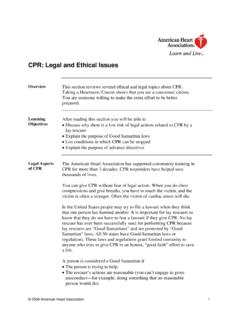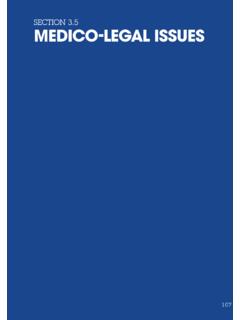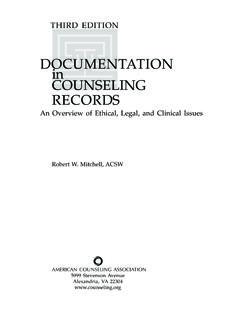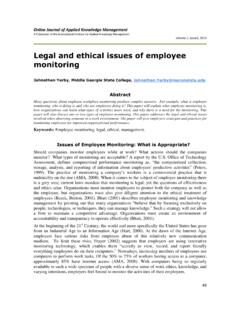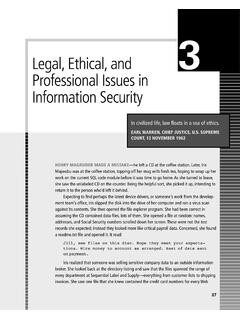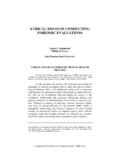Transcription of 11Lesson 11: Ethical and Legal Issues in Web Development
1 11 Lesson 11: Ethical and Legal Issues in Web Development Objectives By the end of this lesson, you will be able to: : Define ethics, and distinguish between Legal and Ethical Issues . : Use Web content ( , text, graphics, code) properly, including original content, misleading/inaccurate information, copyrighted content, licensing, avoiding infringement. : Use strategies to avoid violating end-user privacy and trust ( , refusing to share or sell end-user information, opt-in/opt-out for mailing lists). : Develop privacy disclaimers appropriate to site purpose and audience. : Identify international Legal Issues , including fair use, trademarks, contracts. 11-2 Web Design Specialist 2013 Certification Partners, LLC All Rights Reserved Version Pre-Assessment Questions 1. What is the difference between Legal conduct and Ethical conduct?
2 2. Which of the following is an illegal act, rather than an unethical act, in the Web Development profession? a. Passing along chain e-mail messages b. Buying domain names you do not intend to use c. Copying an image from a Web site and publishing it without permission d. Inflating the prices you charge customers for your technological services 3. Which of the following does a copyright protect? a. The right to practice unpopular forms of communication such as spam b. Original works of authorship such as writing, art, music or program code c. Names, phrases, pictures or drawings that a company uses to distinguish itself from the competition d. The right to quote or refer to someone else's intellectual property if you provide source attribution Lesson 11: Ethical and Legal Issues in Web Development 11-3 2013 Certification Partners, LLC All Rights Reserved Version Ethics and Law in Web Development As trained professionals who provide services to customers, Web developers must be familiar with the Ethical Issues and laws that pertain to businesses operating on the Web.
3 Currently, many laws related to Web businesses and practices are not completely clear; others are evolving each day as court cases and legislation are addressed and settled. However, the law is only a baseline for the conduct you should observe some practices may currently be Legal , but the lack of a forbidding law does not necessarily make them acceptable. The Web (and business in general) has many accepted professional standards of conduct that all Web developers should follow, called ethics. Ethics deal with good versus bad: values, moral duty and obligation. Some practices that are still Legal are considered unethical by professional standards. As a professional Web developer, you have a responsibility to your customers to inform them of practices that are questionable or illegal in relation to their projects. You should also make decisions and conduct your own business in ways that will reflect well upon you, upon Web developers in general, and upon CIW-trained Web designers.
4 Ethical Issues and the Web Ethics are a set of standards governing the conduct of members of a profession. Ethics establish basic values for responsible actions and practices within a professional community. Although there may be no punishment for violating Ethical standards, some practices (such as spamming and sending viruses) are being written or will be written into law. The generally agreed-upon Ethical standards for Web professionals have developed from years of experience, and many have been inherited from other professions. Examples of Ethical behavior for Web professionals include the following: Do not send unsolicited bulk e-mail, or spam. Do not buy domain names that you do not intend to use (a practice also known as domain squatting or cyber-squatting). Do not knowingly spread malicious program code such as viruses or worms.
5 Do not pass along chain e-mail messages, especially those that imply threats. Be honest with your customers, and do not overcharge for technical services that they may not understand. Spam Spam is unsolicited bulk e-mail that is, e-mail messages that the recipients did not ask to receive. As you are undoubtedly aware, millions (if not billions) of spam messages are sent to Web users every day. A multitude of software companies have launched in recent years that are devoted exclusively to creating spam filters, which sort unwanted spam from wanted e-mail for the e-mail user. NOTE: Be sure you understand the differences between illegal and unethical practices. NOTE: Can you recall any news stories involving illegal or unethical Web practices? OBJECTIVE : Ethics, Legal vs. Ethical Issues NOTE: Do you feel any unethical practices are deserving of punishment or illegal status?
6 Spam Unsolicited and unwanted e-mail messages; the online equivalent of junk mail. spam filter An e-mail client program that identifies and filters out spam messages before they reach the e-mail Inbox. 11-4 Web Design Specialist 2013 Certification Partners, LLC All Rights Reserved Version Bulk e-mail and business Many legitimate businesses use bulk e-mailing as a way to advertise their Web sites and promotions to the online audience. E-mail lists are generally managed using a mailing list server, which is a server that automates the distribution of messages to an authorized group of participants. A user can subscribe to the list by sending an e-mail message to the list server, or by authorizing a Web site to subscribe him or her to its e-mail service for newsletters, specials and so forth. List servers can also receive messages from listserve group participants, store the messages and distribute them to the mailing list.
7 This function is generally used only by mailing list groups in which members subscribe to discuss specific topics with other members. Mailing lists used for advertisement generally do not offer recipients the option to communicate with other recipients on the list. Opt-in and opt-out e-mail If you want to use bulk e-mailing to promote your Web site, you should avoid being labeled a spammer at all costs. To create a legitimate e-mail list, you must give users the option to subscribe to your e-mail list, which they can do by submitting a form on your Web site or by checking a box when they complete a transaction. This type of e-mail list creates an opt-in e-mailing service, and it is the only way to build a legitimate customer e-mailing list. Opt-in e-mail lists consist exclusively of users who specifically requested or authorized their addition to the list.
8 This includes listserve group members and recipients of promotional e-mail from businesses. Opt-out e-mail messages are bulk e-mail that offer recipients the option of unsubscribing from the list, generally by clicking a link in the message or visiting a Web page. Recipients of opt-out e-mail are expected to unsubscribe themselves from the list if they do not want to continue receiving the e-mail; otherwise, they are assumed to have authorized the messages. The opt-out capability is implied for all opt-in e-mail services. However, this capability is often used by spammers as an attempt to legitimize spam by giving the appearance that users on the list requested their subscription. In some cases, spammers even use the opt-out response mechanism to create lists of recipients for additional unsolicited e-mail; clicking the opt-out link from an unscrupulous messenger's e-mail may actually confirm your address as a target for further spam.
9 Opt-out e-mail is often used by legitimate businesses to subscribe users who have not requested the e-mail service but whose e-mail addresses were collected by the Web site for other purposes (such as completing a purchase or obtaining a site password). These recipients are then given the responsibility to unsubscribe themselves if they do not want to receive the unrequested e-mail. The opt-out method for creating a mailing list in this way is not recommended if you want your customers to feel confident about using your Web site. Some may find receiving your unsolicited e-mail messages so annoying that they will not return to your site. However, remember that you can provide good customer service by adding a convenient opt-out function to the e-mail messages you send to your opt-in e-mail list recipients. Privacy and trust Web server software collects information about Web site visitors through the creation of log files.
10 These automatically generated log files contain information such as the pages a user viewed, the type of browser used, and the duration of a user's visit. By using cookies, the Web server can also record when a user returns to the site. mailing list server An e-mail server that regularly sends e-mail messages to a specified list of users. List servers can also collect and distribute messages from an authorized group of participants, called a listserve group. OBJECTIVE : Strategies for end-user privacy and trust opt-in e-mail An e-mail list service that is created legitimately by subscribing only users who specifically request to be added to the list. opt-out e-mail An e-mail list service that requires subscribers to unsubscribe themselves if they do not want to continue receiving messages. Opt-out is implied for opt-in e-mail services, although it is often used in unsolicited e-mailing lists to give the appearance that recipients requested their addition (opted in) to the list.





